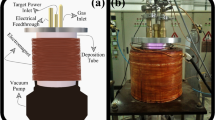Abstract
In the thermionic two component system consisting of a refractory metal surface and Cs the only parameter that allows for an enhancing of efficiency is the nature of the metal surface. Surfaces obtained by the follwing techniques are studied: 1. radio-frequency inductive plasma sputtering, 2. van der Schueren evaporation, a sublimation technique, 3. vapor plating. The surfaces obtained by the mentioned techniques are studied as to their adhesion and grain size. A modified Shelton retarding current method allows for the determination of the distribution of work functions. The improvements in diode-efficiency to be obtained by improving the metal surfaces are probably limited. It has been shown that significant improvements can be hoped for by introducing a third component in the system. Thus techniques for the handling of barium are studied.
Similar content being viewed by others
References
Wilson, V. C.: Conversion of heat to electricity by thermionic emission. J. appl. Phys.30 (1959) no. 4 pp. 475/81.
Zalm, P.: Semiconduction and electron emission. 21st Conf. Phys. Electronics Mass. Inst. Technol. (M.I.T.) 1961, pp. 62/66; espec. p. 62.
Rasor, N. S., andC. Warner: Correlation of emission processes for adsorbed alkali films on metal surfaces. J. appl. Phys.35 (1964) no. 9 pp. 2589/600.
Formenko, V. S.: Handbook of thermionic properties. New York: Plenum Press Data Division 1966.
Shuppe, G. N.: Emission parameters of different faces of tungsten, molybdenum and tantalum single crystals (clean and contaminated). Bull. Acad. Sci. (Physics) USSR30 (1966) no. 12 pp. 2016/23; espec. p. 2017.
Brossa, F., H. W. Schleicher, u.H. Venker: Über die Abscheidung von Nb, Ta, Mo und W durch Reduktion der entsprechenden Chloride mit Zn-Dampf. Metalloberfläche21 (1967) no. 6 pp. 175/76.
Beucherie, P., M. Block u.J. G. Wurm: A new radio-frequency inductive plasma sputtering process of surface coating. J. Electrochem. Soc.116 (1969) no. 1 pp. 159/60.
Verfahren zur Herstellung von Aufdampfschichten in Vakuum. Eurospectra9 (1970) no. 1 pp. 25/27.
Schins, H. E. J., L. Kobus, G. di Cola et al.: Determination of bare work function distributions using retarding current plots. 3rd Internat. Conf. on Thermionic Electric Power Generation, Jülich 5th to 9th June 1972. To be published by Intern. Atomic Energy Agency; Paris 1972.
Henner, R.: Thermionic energy conversion with mixed vapors. Thermionic Conversion Specialist Conf. 1971 San Diego, USA, S. IV. 10/V-1. New York: I.E.E.E. Headquarters 1972.
Houston, J. M. andH. F. Webster: Thermionic energy conversion. In: Advances in electronics and electron physics. Vol. 17. New York: Academic Press (1962); pp. 125/206; espec. S. 176.
Grover, G. M.: Direct conversion: Los Alamos plasma thermocouple. Nucleonics17 (1959) no. 7 pp. 54/55.
Zalm, P.: Naehlieferungskathoden mit Osmium. Philips Techn. Rdsch.27 (1966) no. 5/6 pp. 121/28.
Author information
Authors and Affiliations
Additional information
Überarbeitete Fassung eines auf dem vom Institut für Kernenergetik der Universität Stuttgart veranstalteten zweiten Symposium über thermophysikalische Eigenschaften fester Stoffe gehaltenen Vortrags.
Rights and permissions
About this article
Cite this article
Schins, H.E.J. Thermionic electrodes technology. Forsch Ing-Wes 38, 151–153 (1972). https://doi.org/10.1007/BF02573831
Received:
Issue Date:
DOI: https://doi.org/10.1007/BF02573831




